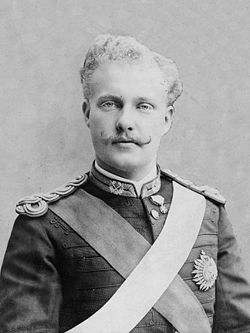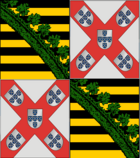Carlos I of Portugal
|
||||||||||||||||||||||||||||||||||
|
||||||||||||||||||||||||||||||||||
Carlos I (pronounced [ˈkaɾɫuʃ]; Eng. Charles), the Diplomat (also known as the Martyr) (Port.o Diplomata and o Martirizado) - (Lisbon, September 28, 1863 - Lisbon, February 1, 1908) named Carlos Fernando Luís Maria Victor Miguel Rafael Gabriel Gonzaga Xavier Francisco de Assis José Simão de Bragança-Sabóia-Bourbon e Saxe-Coburgo-Gota was the 33rd (or 34th or 35th according to some historians) and penultimate King of Portugal and the Algarves. He was the first Portuguese king to die a violent death since Sebastian of Portugal (1578). This occurred in 1908, when Carlos was murdered in Lisbon as he travelled in an open carriage with the royal family.
Contents |
Early life
Carlos was born in Lisbon, Portugal, the son of King Luís and Princess Maria Pia of Savoy, daughter of Victor Emmanuel II, King of Italy. He had a brother, Infante Afonso, Duke of Porto.
His paternal first cousins included (among others) Frederick Augustus III of Saxony, Princess Maria Josepha of Saxony, Prince Wilhelm of Hohenzollern-Sigmaringen and Ferdinand I of Romania.
His maternal first cousins included (among others) Napoléon Victor Bonaparte, Victor Emmanuel III of Italy, Emanuele Filiberto, 2nd Duke of Aosta, Vittorio Emanuele, Count of Turin, Luigi Amedeo, Duke of the Abruzzi, Umberto, Count of Salemi.
He had an intense education and was prepared to rule as a constitutional monarch. In 1883 he traveled to Italy, England, France and Germany where he increased his knowledge of the modern civilization of his time. In 1883, 1886 and 1888 he ruled as regent as his father was traveling in Europe, as it became tradition among the Portuguese constitutional kings. His father Luis I advised him to be modest and to study with focus.
His first bridal candidate was one of the daughters of Frederick III, German Emperor, but the issue of religion presented an insurmountable problem and the pressure of British diplomacy prevented the marriage. He then met and married Princess Amélie of Orléans, eldest daughter of Philippe, comte de Paris, pretender to the throne of France.
King of Portugal
Carlos became King on October 19, 1889. An intelligent but extravagant man, Carlos's policies, perceived wastefulness and extramarital affairs effectively sealed the fate of the Portuguese monarchy. Colonial treaties with the United Kingdom of Great Britain and Ireland (one signed in August 1890 that defined their African borders along the Zambezi and Congo rivers and another signed on October 14, 1899, that confirmed colonial treaties of the 17th century) stabilised the situation in Africa. These agreements were however unpopular in Portugal where they were seen as being to the disadvantage of the country.
Domestically, Portugal was twice declared bankrupt - on June 14, 1892, and again on May 10, 1902 - causing industrial disturbances, socialist and republican antagonism and press criticism of the monarchy. Carlos responded by appointing João Franco as prime minister and subsequently accepting parliament's dissolution.
As a patron of science and the arts, King Carlos took an active part in the celebration of the 500th anniversary (in 1894) of the birth of Prince Henry the Navigator. The following year he decorated the famous Portuguese poet Joao de Deus in a ceremony in Lisbon. Carlos took a personal interest in deep-sea and maritime exploration, publishing an account of his own studies in this area.

Assassination
On February 1, 1908 the royal family returned from the palace of Vila Viçosa to Lisbon. They travelled by train to Almada and, from there, took a steamer to cross the Tagus River and disembarked in Cais do Sodré in central Lisbon. On their way to the royal palace, the open carriage with Carlos I and his family passed through the Terreiro do Paço fronting on the river. While crossing the square, shots were fired from the crowd by two republican activists: Alfredo Costa and Manuel Buiça. Buica, who was a former army sergeant and sharpshooter, fired five shots from a rifle hidden under his long overcoat. The king died immediately, his heir Luís Filipe was mortally wounded, and Prince Manuel was hit in the arm. The Queen alone escaped death or injury. The two assassins were shot dead on the spot by police and bodyguards, as was a bystander in the confusion. The royal carriage turned into the nearby Navy Arsenal where, about twenty minutes later, the Prince Royal Luis Filipe died. Several days later the younger son Prince Manuel was acclaimed King of Portugal; the last of the Braganza dynasty.
Marriage and children
Carlos was married to Princess Amélie of Orléans in 1886. She was daughter of Philippe, Comte de Paris and Marie Isabelle d'Orléans. Their children were:
- Luis Filipe, Duke of Braganza (1887-1908);
- Manuel II, king of Portugal between 1908 and 1910 (1889-1932);
- Maria Anna of Braganza, princess of Portugal (1887–1887).
A woman known as Maria Pia de Saxe-Coburgo-Bragança claimed (many years after his death) that she was the illegitimate daughter of Carlos I by Maria Amélia Laredo e Murça.
Influence on Jack London
| Monarchical Styles of King Carlos I of Portugal |
|
 |
|
| Reference style | His Most Faithful Majesty |
|---|---|
| Spoken style | Your Most Faithful Majesty |
| Alternative style | Sire |
Jack London's science fiction story "The Enemy of All the World", published less than five years after the assassination of King Carlos I (see[1]), included a fictional account of an assassination of the King and Queen of Portugal, directly after their marriage, set in 1933 - then a future date - and evidently inspired by the recent actual assassination:
(...) It was their wedding day. All possible precautions had been taken against the terrorists, and the way from the cathedral, through Lisbon's streets, was double-banked with troops, while a squad of two hundred mounted troopers surrounded the carriage. Suddenly the amazing thing happened. The automatic rifles of the troopers began to go off, as well as the rifles, in the immediate vicinity, of the double-banked infantry. In the excitement the muzzles of the exploding rifles were turned in all directions. The slaughter was terrible - horses, troops, spectators, and the King and Queen, were riddled with bullets. To complicate the affair, in different parts of the crowd behind the foot-soldiers, two terrorists had bombs explode on their persons. These bombs they had intended to throw if they got the opportunity. But who was to know this? The frightful havoc wrought by the bursting bombs but added to the confusion; it was considered part of the general attack.
Ancestors
| Ancestors of Carlos I of Portugal | ||||||||||||||||||||||||||||||||||||||||||||||||||||||||||||||||||||||||||||||||||||||||||||||||||||||||||||||||||||||||||||||||||||||||||||||||||||||||||||||||||||||||||||||||||||||||||||||||||||||||||||||||||||||||||||||||||||||||||||||||||||||||||||||||||||||||||||||||||||||||||||||||||||||||||||||||||||||||||||||||||||||||||||||||||||||||||||||||||||||||||||||||||||||||||||||||||||||||||||||||||||||||||||||||||||||||||||||||||||||||||||||||||||||||||||||||||||||||||||||||||||||||||||||||||||||||||||||||||||||||||||||||||||||||||||||||||
|---|---|---|---|---|---|---|---|---|---|---|---|---|---|---|---|---|---|---|---|---|---|---|---|---|---|---|---|---|---|---|---|---|---|---|---|---|---|---|---|---|---|---|---|---|---|---|---|---|---|---|---|---|---|---|---|---|---|---|---|---|---|---|---|---|---|---|---|---|---|---|---|---|---|---|---|---|---|---|---|---|---|---|---|---|---|---|---|---|---|---|---|---|---|---|---|---|---|---|---|---|---|---|---|---|---|---|---|---|---|---|---|---|---|---|---|---|---|---|---|---|---|---|---|---|---|---|---|---|---|---|---|---|---|---|---|---|---|---|---|---|---|---|---|---|---|---|---|---|---|---|---|---|---|---|---|---|---|---|---|---|---|---|---|---|---|---|---|---|---|---|---|---|---|---|---|---|---|---|---|---|---|---|---|---|---|---|---|---|---|---|---|---|---|---|---|---|---|---|---|---|---|---|---|---|---|---|---|---|---|---|---|---|---|---|---|---|---|---|---|---|---|---|---|---|---|---|---|---|---|---|---|---|---|---|---|---|---|---|---|---|---|---|---|---|---|---|---|---|---|---|---|---|---|---|---|---|---|---|---|---|---|---|---|---|---|---|---|---|---|---|---|---|---|---|---|---|---|---|---|---|---|---|---|---|---|---|---|---|---|---|---|---|---|---|---|---|---|---|---|---|---|---|---|---|---|---|---|---|---|---|---|---|---|---|---|---|---|---|---|---|---|---|---|---|---|---|---|---|---|---|---|---|---|---|---|---|---|---|---|---|---|---|---|---|---|---|---|---|---|---|---|---|---|---|---|---|---|---|---|---|---|---|---|---|---|---|---|---|---|---|---|---|---|---|---|---|---|---|---|---|---|---|---|---|---|---|---|---|---|---|---|---|---|---|---|---|---|---|---|---|---|---|---|---|---|---|---|---|---|---|---|---|---|---|---|---|---|---|---|---|---|---|---|---|---|---|---|---|---|---|---|---|---|---|---|---|---|---|---|---|---|---|---|---|---|---|---|---|---|---|---|---|---|---|---|---|---|---|---|---|---|---|---|---|---|---|---|---|---|---|---|---|---|---|---|---|---|---|---|---|---|---|---|---|---|---|---|---|---|---|---|---|---|---|---|---|---|---|---|---|---|---|---|---|---|---|---|---|---|---|---|---|---|---|---|---|---|---|---|---|---|---|---|---|---|---|---|---|---|---|---|---|---|---|---|---|---|---|---|---|---|---|---|---|---|---|
|
||||||||||||||||||||||||||||||||||||||||||||||||||||||||||||||||||||||||||||||||||||||||||||||||||||||||||||||||||||||||||||||||||||||||||||||||||||||||||||||||||||||||||||||||||||||||||||||||||||||||||||||||||||||||||||||||||||||||||||||||||||||||||||||||||||||||||||||||||||||||||||||||||||||||||||||||||||||||||||||||||||||||||||||||||||||||||||||||||||||||||||||||||||||||||||||||||||||||||||||||||||||||||||||||||||||||||||||||||||||||||||||||||||||||||||||||||||||||||||||||||||||||||||||||||||||||||||||||||||||||||||||||||||||||||||||||||
References
- Jean Pailler: D. Carlos I - Rei de Portugal: Destino Maldito de um Rei Sacrificado. Bertrand, Lisbon, 2001, ISBN 978-97-2251-231-2
- Jean Pailler: Maria Pia: A Mulher que Queria Ser Rainha de Portugal. Bertrand, Lisbon, 2006, ISBN 972-25-1467-9
- Rui Ramos: D. Carlos, Temas e Debates, Lisbon, 2007.
|
Carlos I of Portugal
House of Braganza-Saxe-Coburg and Gotha
Cadet branch of the House of Saxe-Coburg and Gotha
Born: 28 September 1863 Died: 1 February 1908 |
||
| Regnal titles | ||
|---|---|---|
| Preceded by Louis I |
King of Portugal and the Algarves 1889 – 1908 |
Succeeded by Manuel II |
|
||||||||||||||||||||

